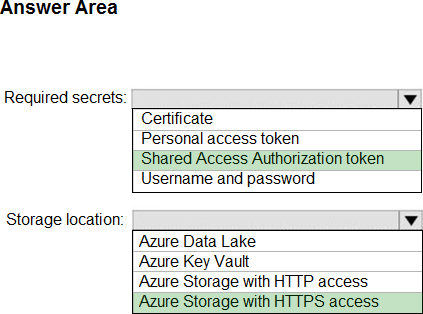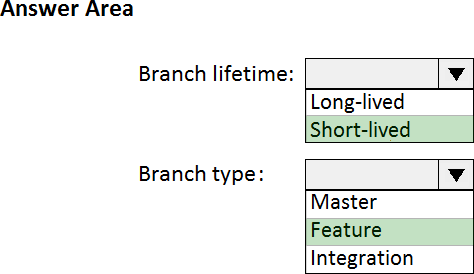Microsoft AZ-400 Übungsprüfungen
Zuletzt aktualisiert am 31.12.2025- Prüfungscode: AZ-400
- Prüfungsname: Designing and Implementing Microsoft DevOps Solutions
- Zertifizierungsanbieter: Microsoft
- Zuletzt aktualisiert am: 31.12.2025
You plan to provision a self-hosted Linux agent.
Which authentication mechanism should you use to register the self-hosted agent?
- A . personal access token (PAT)
- B . SSH key
- C . Alternate credentials
- D . certificate
Introductory Info
Case Study
This is a case study. Case studies are not timed separately. You can use as much exam time as you would like to complete each case. However, there may be additional case studies and sections on this exam. You must manage your time to ensure that you are able to complete all questions included on this exam in the time provided.
To answer the questions included in a case study, you will need to reference information that is provided in the case study. Case studies might contain exhibits and other resources that provide more information about the scenario that is described in the case study. Each question is independent of the other questions in this case study.
At the end of this case study, a review screen will appear. This screen allows you to review your answers and to make changes before you move to the next section of the exam. After you begin a new section, you cannot return to this section.
To start the case study
To display the first question in this case study, click the Next button. Use the buttons in the left pane to explore the content of the case study before you answer the questions. Clicking these buttons displays information such as business requirements, existing environment, and problem statements. If the case study has an All Information tab, note that the information displayed is identical to the information displayed on the subsequent tabs. When you are ready to answer a question, click the Question button to return to the question.
Overview
Litware, Inc. is an independent software vendor (ISV). Litware has a main office and five branch offices.
Existing Environment
Application Architecture
The company’s primary application is a single monolithic retirement fund management system based on ASP.NET web forms that use logic written in VB.NET.
Some new sections of the application are written in C#.
Variations of the application are created for individual customers. Currently, there are more than 80 live code branches in the application’s code base.
The application was developed by using Microsoft Visual Studio. Source code is stored in Team Foundation Server (TFS) in the main office.
The branch offices access the source code by using TFS proxy servers.
Architectural Issues
Litware focuses on writing new code for customers. No resources are provided to refactor or remove existing code. Changes to the code base take a long time, as dependencies are not obvious to individual developers.
Merge operations of the code often take months and involve many developers. Code merging frequently introduces bugs that are di cult to locate and resolve.
Customers report that ownership costs of the retirement fund management system increase continually. The need to merge unrelated code
makes even minor code changes expensive.
Customers report that bug reporting is overly complex.
Requirements
Planned Changes
Litware plans to develop a new suite of applications for investment planning. The investment planning applications will require only minor integration with the existing retirement fund management system.
The investment planning applications suite will include one multi-tier web application and two iOS mobile applications. One mobile application will be used by employees; the other will be used by customers.
Litware plans to move to a more agile development methodology. Shared code will be extracted into a series of packages.
Litware has started an internal cloud transformation process and plans to use cloud-based services whenever suitable.
Litware wants to become proactive in detecting failures, rather than always waiting for customer bug reports.
Technical Requirements
The company’s investment planning applications suite must meet the following technical requirements:
New incoming connections through the firewall must be minimized.
Members of a group named Developers must be able to install packages.
The principle of least privilege must be used for all permission assignments.
A branching strategy that supports developing new functionality in isolation must be used.
Members of a group named Team Leaders must be able to create new packages and edit the permissions of package feeds.
Visual Studio App Center must be used to centralize the reporting of mobile application crashes and device types in use.
By default, all releases must remain available for 30 days, except for production releases, which must be kept for 60 days.
Code quality and release quality are critical. During release, deployments must not proceed between stages if any active bugs are logged against the release.
The mobile applications must be able to call the share pricing service of the existing retirement fund management system. Until the system is upgraded, the service will only support basic authentication over HTTPS.
The required operating system configuration for the test servers changes weekly. Azure Automation State Configuration must be used to ensure that the operating system on each test server is configured the same way when the servers are created and checked periodically.
Current Technical Issue
The test servers are configured correctly when first deployed, but they experience configuration drift over time. Azure Automation State Configuration fails to correct the configurations.
Azure Automation State Configuration nodes are registered by using the following command.

HOTSPOT
You need to configure a cloud service to store the secrets required by the mobile applications to call the share pricing service.
What should you include in the solution? To answer, select the appropriate options in the answer area. NOTE: Each correct selection is worth one point.
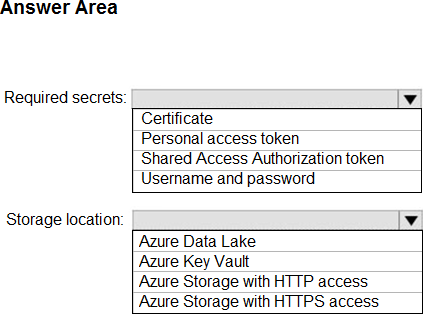
Note: This question is part of a series of questions that present the same scenario. Each question in the series contains a unique solution that might meet the stated goals. Some question sets might have more than one correct solution, while others might not have a correct solution.
After you answer a question in this section, you will NOT be able to return to it. As a result, these questions will not appear in the review screen.
You manage a project in Azure DevOps.
You need to prevent the configuration of the project from changing over time.
Solution: Add a code coverage step to the build pipelines.
Does this meet the goal?
- A . Yes
- B . No
HOTSPOT
You have an Azure subscription that contains two resource groups named ContosoRG and ContosoDev, an Azure data factory named Contoso Data Factory, and a release pipeline in Azure Pipelines named Pipeline1.
You plan to deploy Contoso Data Factory to ContosoRG by using Pipeline1.
You add the Azure Resource Manager (ARM) template deployment task shown in the following exhibit.
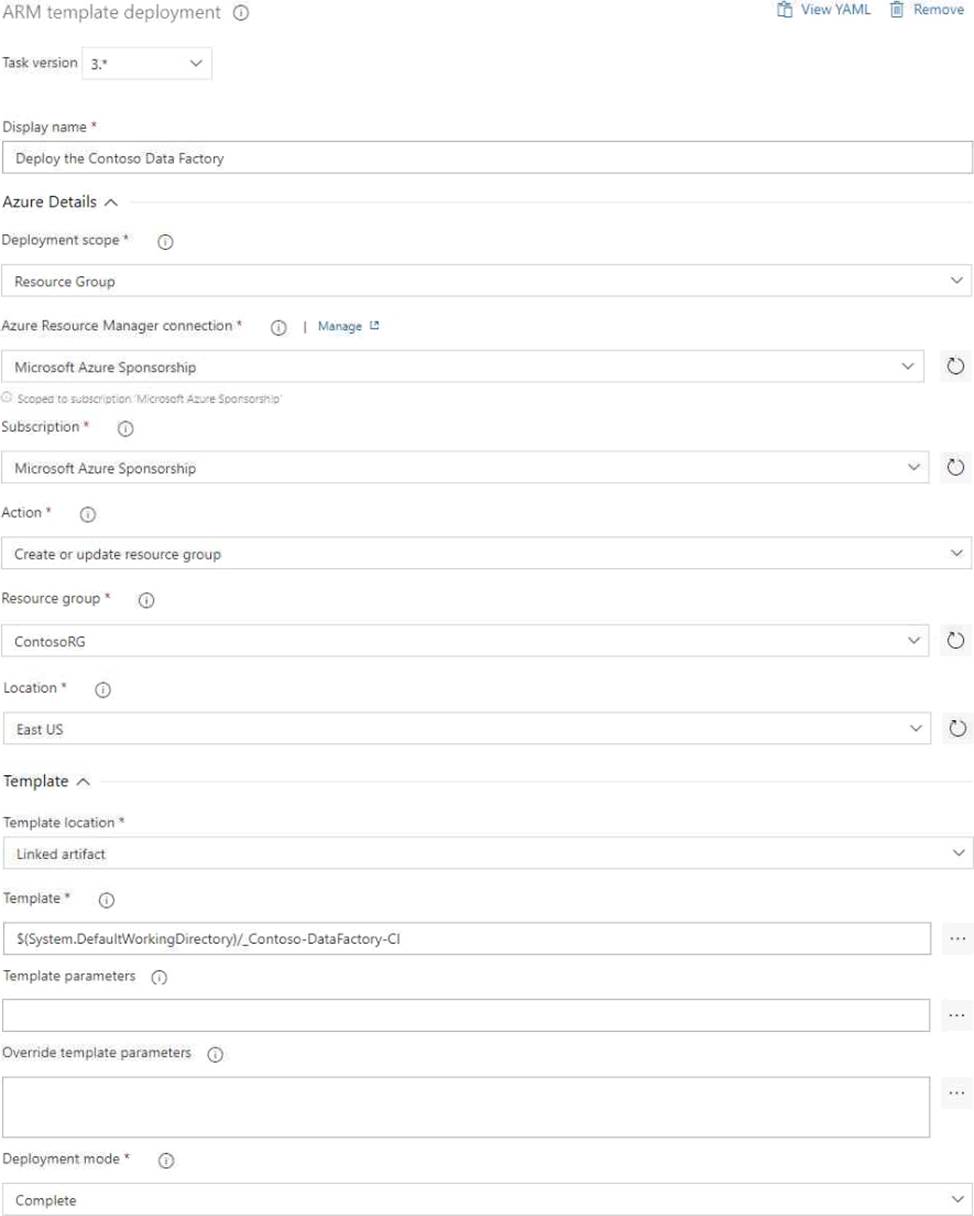
Use the drop-down menus to select the answer choice that completes each statement based on the information presented in the graphic. NOTE: Each correct selection is worth one point.

Note: This question is part of a series of questions that present the same scenario. Each question in the series contains a unique solution that might meet the stated goals. Some question sets might have more than one correct solution, while others might not have a correct solution.
After you answer a question in this section, you will NOT be able to return to it. As a result, these questions will not appear in the review screen.
Your company has a project in Azure DevOps for a new web application.
You need to ensure that when code is checked in, a build runs automatically.
Solution: From the Triggers tab of the build pipeline, you select Batch changes while a build is in progress.
Does this meet the goal?
- A . Yes
- B . No
HOTSPOT
Your company uses Git as a source code control system for a complex app named App1.
You plan to add a new functionality to App1.
You need to design a branching model for the new functionality.
Which branch lifetime and branch time should you use in the branching model? To answer, select the appropriate options in the answer area. NOTE: Each correct selection is worth one point.
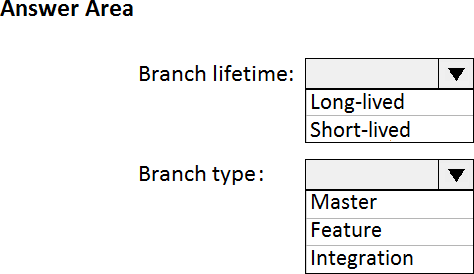
You plan to create an image that will contain a .NET Core application.
You have a Dockerfile file that contains the following code. (Line numbers are included for reference only.)
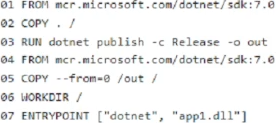
You need to ensure that the image is as small as possible when the image is built.
Which line should you modify in the le?
- A . 1
- B . 3
- C . 4
- D . 7
You use an Azure Pipelines pipeline to build, test, and deploy an app named App1.
You need to reduce how long it takes to complete unit and integration tests for App1. The solution must ensure that the code coverage testing ratio is maintained.
What should you do?
- A . Enable aky test management.
- B . Purchase additional parallel jobs.
- C . Enable Test Impact Analysis (TIA).
- D . Add an agent pool.
HOTSPOT
You are using PowerShell to administer Azure Log Analytics workspaces.
You need to list the available workspaces and their properties.
How should you complete the command? To answer, select the appropriate options in the answer area. NOTE: Each correct selection is worth one point.

HOTSPOT
You are using PowerShell to administer Azure Log Analytics workspaces.
You need to list the available workspaces and their properties.
How should you complete the command? To answer, select the appropriate options in the answer area. NOTE: Each correct selection is worth one point.


